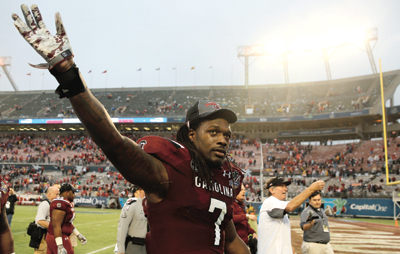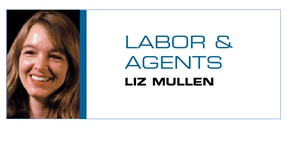During Super Bowl week in New York, NFL player agent
Ryan Tollner walked his client, University of Central Florida quarterback
Blake Bortles, up to NFL talent guru
Gil Brandt in the media center and introduced the two men.
Brandt is the former Dallas Cowboys head of player personnel who is a prolific voice on the NFL draft. “It’s funny,” Tollner said, a week later. “I saw Gil Brandt and Gil had [Bortles] listed at 6-3, 225 [pounds]. I said, ‘Gil, do you want to change that? He is 6-5 and 240.’”
The fact that an agent is touting his client’s size isn’t particularly notable, though Bortles’ stature could prove an important factor in whether the Houston Texans take him as the No. 1 pick in the NFL draft in May. Bortles is competing for the spot with two other quarterbacks, Louisville’s Teddy Bridgewater and Texas A&M’s Johnny Manziel, who are better known but smaller in height.
What is notable, though, is the fact that Tollner is representing Bortles at all.
 |
Clowney, like other prospective top picks, went small when picking representation.
Photo by: GETTY IMAGES
|
While the sports industry has never had so many large multisport and entertainment agencies representing talent, these three top quarterback prospects, as well as talented South Carolina defensive end
Jadeveon Clowney, are represented by relatively small players in the representation business.
The rare development has led to widespread talk in agent circles, who question the players’ unusual choices in the management teams surrounding them. But few can determine if this is the start of a trend or aberration when it comes to player representation.
Rep1 Sports, which is owned by Tollner and his older cousin, Bruce Tollner, represent Bortles on and off the field. Select Sports Group NFL agent Erik Burkhardt represents Manziel on the field and LRMR Marketing co-owner Maverick Carter, who handles all off-the-court matters for LeBron James, represents Manziel for marketing and other off-the-field work.
Veteran NFL agent Bus Cook’s BC Sports signed Clowney, who talent experts say may be one of the most gifted athletes to come along in years, for on- and off-the-field work. And Bridgewater is represented by NFL agent Kennard McGuire for playing contract work, but had not signed with a marketing agent, instead using former NFL safety Abe Elam as his adviser.
“The landscape of the business is very odd this year,” said one NFL agent who has represented multiple top-10 draft picks. “People are picking people who have not had top picks.”
This agent, and others interviewed for this story, asked for anonymity for a variety of reasons, especially for talking about another player/agent relationship.
The possible reasons are varied. For years, some agents have claimed privately that their competitors cut fees or offered large marketing guarantees to sign the top players. Most agents believe that is continuing, but no one could provide any specific evidence.
Some say, too, the 2011 NFL collective-bargaining agreement may be a factor, as the money for top picks is half of what it used to be and there are fewer terms to negotiate and far less complicated negotiations.
Brandt says he doesn’t know exactly why the players picked the agents, but he doesn’t think it necessarily portends a sea change in the business.
“I think it’s relationships that have a great deal to do with it,” Brandt said.
Additionally, some note that young agents have been working hard to break through into the top echelon of about a dozen agencies that have represented most of the top NFL draft picks.
“It is just there are so many guys in the business these days,” Cook said. “There are a lot of people trying to get players. It’s just getting more and more competitive.”
In the last decade, most of the No. 1 picks have been represented by experienced agents who tout years in the business. Not so this year.
Ryan Tollner, Bortles’ primary agent, and Burkhardt, are relatively young to be representing the potential No. 1 selection. Tollner is 37 and Burkhardt is 33. Neither has represented a No. 1 pick before, although Tollner is the agent for Pittsburgh Steelers quarterback Ben Roethlisberger, who he co-represented with Leigh Steinberg when Roethlisberger was the No. 11 pick in the 2004 NFL draft.
Tollner had no previous history with Bortles, and landed him just by out-recruiting the others.
However, Manziel and Burkhardt are both from Texas and that was a factor in Manziel signing with Burkhardt, Brad Beckworth, attorney for the Manziel family, told SportsBusiness Journal.
On the other end of the spectrum, Cook, at 65, is representing Clowney and having one of his best years ever as an agent. He has represented high draft picks before, including high-profile quarterbacks Brett Favre, Russell Wilson and former No. 1 pick Cam Newton.
But Cook’s signing of Clowney was a surprise, as many believed the University of South Carolina star was expected to sign with Jay Z’s Roc Nation Sports. Clowney and Jay Z are “friends, acquaintances, whatever,” Cook said, adding he signed Clowney after an interview process involving some of the best NFL agents in the country. “I interviewed with his mother and with him, but as far as knowing him way back when, I did not,” Cook said.
Bridgewater may have the most unusual representation of all four players. His support team, as well as the timing of his draft preparation process, has many in the industry puzzled. For a while, it looked like Bridgewater wasn’t going to pick an agent at all, as he interviewed many of the top agents in early January, yet didn’t sign with an agent for weeks. He later signed with the veteran McGuire, who has never represented a No. 1 pick. McGuire, asked why Bridgewater chose him, said, “Honestly, I can’t say. What I can say is I am happy he chose me.”
■ ■ ■
Some wonder what impact an athlete’s representation team might have on players vying for No. 1. Others say the agent doesn’t matter at all.
The Texans hold the first pick in the draft, and as usual, the team was mum on its thinking but did address the importance of the agent in the process.
“My expectation is, regardless of whoever it is that we pick, that we try to maintain positive relationships with the agent community,” said Texans general manager Rick Smith.
Since the new NFL collective-bargaining agreement was signed, the amount of money that a top first-round pick can earn is about half of what it used to be, and that has led some to question the value of even having a formal agent represent a player during the process. But agents respond that even though the money available may be less, the sums are still significant and sliding to a lower draft pick can cost a player significant dollars.
“Some people are saying there is no need for agents,” Cook said. “But, you know, a guy who is representing himself may do OK, but if he falls one slot because of it, he’s probably made a mistake in representing himself.”
This year the No. 1 pick can earn in the ballpark of $22.3 million versus $21.3 million for the No. 2 pick for a four year-rookie deal.
If the player drops to No. 5, the amount is about $18.7 million. The No. 10 pick would get about $12.3 million over four years.
Agents note there is still plenty to be negotiated in a rookie’s contract, such as guarantees, roster bonuses, workout bonuses and other things an inexperienced agent or a player representing himself are not as familiar with negotiating.
Andrew Brandt, a former NFL agent and general counsel for the Green Bay Packers who currently is an analyst for ESPN and SI, said he thinks players still need an agent, but the fee model should be changed to possibly a flat fee or an hourly fee for contract and other services. Currently, agents can charge a maximum fee of 3 percent of the contact value.
“There are different parts of the draft where there may be nuances where an agent could help,” he said. “Things like roster bonuses, workout bonuses later in the contract, as well as the structure of the payment of bonuses. I think for the actual contact, terms are fairly prefabricated at all levels. But the amount you would pay for a [3 percent] fee at the top of the draft is disproportionate as compared to lower rounds of the draft.”
In addition to these contract terms, NFL agents with years of experience have long-standing relationships with NFL club personnel. Successful agents are known for their powers of persuasion, and agents work their club relationships to allay any concerns the team might have about the player, be it a character issue or a physical issue. Additionally, big agencies have lots of players NFL clubs want, which can give those agents leverage. Successful agents plan a course for their players from the day they sign them until they are drafted.
Another area were reps advise players is about appearances — at the combine and even whether to go to the Super Bowl.
Reps for Manziel and Clowney said their players did not attend the Super Bowl or events surrounding the game in New York because they were solely focused on training for the combine.
Before the Super Bowl, Cook told SportsBusiness Journal that Clowney was “not going to do anything that interferes with his draft preparation, and, in particular, for the combine.”
Manziel’s representatives said that he, likewise, was focused on his training.
Bridgewater and Bortles were in New York attending events around the Super Bowl.
Inside the industry, there is debate as to whether bringing a player to the Super Bowl is a good idea. Most agents worry that the parties that fill that week present potential for players getting into trouble or not seeming to be focused on football. But attending Super Bowl week puts the draft prospect in front of teams and other influential people in the NFL.
Bortles’ appearance during Super Bowl week did influence one such person’s opinion: Gil Brandt’s.
Brandt is a big Manziel fan; he has him ranked No. 1 overall on his mock draft. But he said he was impressed with Bortles after meeting him and his agent during Super Bowl week. And he realized, as Tollner said, that he pegged him smaller than he actually was.
“He was bigger,” Brandt conceded of Bortles. “I found out a lot about his family. His brother is a baseball player. He is a quality person and a smart person to visit with. He looks you right in the eye.”
So Bortles’ surprise choice of the youthful Tollner paid an early dividend — altering the perception of one of the more influential people in NFL draft circles.
Liz Mullen can be reached at lmullen@sportsbusinessjournal.com. Follow her on Twitter @SBJLizMullen.





